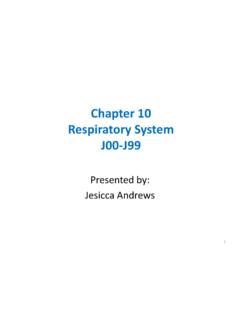Transcription of Chapter 16 Perinatal - CDPHO
1 Chapter 16 conditions originating in the Perinatal PeriodP00-P96 Presented by:Jennifer Kurkulonis1 Overview Perinatal conditions other than congenital anomalies are classified in Chapter 16 of ICD-10-CM. These conditions can be found under the main term Birth or as a subterm under the condition's main term. Perinatal conditions are sequenced as the principal diagnosis but behind the appropriate Z38code for the birth episode. conditions are coded if they meet the definition of reportable conditions or if they have an implication for the newborn's future To Know Newborn immaturityimplies a birth of less than 37 completed weeks gestation Newborn postmaturitya gestational period of more than 42 weeks Newborn low birth weightimplies a birth weight of 1,000-2,499 grams Newborn extremely low birth weightimplies a birth weight of less than 500-999 grams3 Chapter 16 CategoriesP00-P04 Newborn affected by maternal factors and by complications of pregnancy, labor.
2 And delivery P05-P08 Disorders of newborn related to length of gestation and fetal growth P09 Abnormal findings on neonatal screening P10-P15 Birth trauma P19-P29 Respiratory and cardiovascular disorders specific to the perinatalperiod P35-P39 Infections specific to the perinatalperiod P50-P61 Hemorrhagic and hematological disorders of newborn P70-P74 Transitory endocrine and metabolic disorders specific to newborn P76-P78 Digestive system disorders of newborn P80-P83 conditions involving the integument and temperature regulation of newborn P84 Other problems with newborn P90-P96 Other disorders originating in the perinatalperiod 4 Codes from Chapter 16 are neverfound on a maternal recordLocating Codes The perinatalperiod is defined as before birth through the first 28 days after birth. Codes for perinatalconditions are located in the Alphabetic Index by referring to the main term Birthor to the main term for the condition and then to such subterms: newborn neonatal fetal infants infantile If the Alphabetic Index does not provide a specific code for a perinatalcondition, assign code ,Other specified conditions originating in the perinatalperiod,followed by the code from another Chapter that specifies the GUIDELINES Generally, Chapter 16 codes are sequenced as the principal or first-listed diagnosis on the newborn record, except for the appropriate code from the Z38series for the birth episode.
3 Codes from other chapters may be assigned as secondary diagnoses to provide additional detail. The perinatalguidelines for secondary diagnoses are the same as the general coding guidelines for "additional diagnoses . Assign codes for any conditions that have been specified by the provider as having implications for future health care needs. Assign codes from Chapter 16 only for definitive diagnoses established by the provider. If a definitive diagnosis has not been established, codes for signs and symptoms may be assigned. Sometimes a newborn may have a condition that may be either due to the birth process or community acquired. If the documentation does not specify which it is, the default code selected should be due to the birth process. When the condition is community acquired, do not report a Chapter 16 OF AGE TO CODESMost conditions originating during the Perinatal period are transitory in nature.
4 Some conditionsthat originate during this period may persist and some do not manifest themselves until later inlife. These conditions are classified in Chapter 16 and no matter how old the patient is, may bereported throughout the life of the patient if the condition is still present. A 53-year-old woman is admitted for treatment of vaginal carcinoma due to intrauterine exposure to DES (diethylstilbestrol) taken by her mother during pregnancy. Code C52, Malignant neoplasm of vagina,and code Newborn (suspected to be) affected by other maternal noxious substances,are assigned because the intrauterine exposure was still an important element in the patient's condition, even though the problem did not present itself until later in the patient's life. An 18-year-old man was admitted for workup because he had begun experiencing respiratory problems. A diagnosis of bronchopulmonary dysplasia was made, and the patient was discharged to be seen in the physician's office in two weeks.
5 Code , Bronchopulmonary dysplasia originating in the Perinatal period,is assigned because bronchopulmonary dysplasia is a congenital condition even though it may not become a problem until later in the patient's life. 7 CLASSIFICATION OF BIRTHS A code from category Z38is assigned as the principal diagnosis for any newborn. The first axis for coding is whether the birth is single, twin, or multiple. The codes further specify whether the birth occurred in the hospital, outside the hospital, or unspecified as to place of birth. If the birth occurred in the hospital, additional characters indicate the type of delivery (vaginal or cesarean). A code from this series is assigned only on the newborn record and is assigned only for the episode in which the birth occurred. If a newborn is discharged and readmitted or transferred to another facility, the code for the condition responsible for the transfer or readmission is designated as the principal diagnosis.
6 A single livebornvaginally delivered in the hospital with an associated diagnosis of subdural hemorrhage due to birth trauma is coded as , Single liveborninfant, delivered vaginally,and , Subdural hemorrhage due to birth injury,with the Z code sequenced first. If the infant is discharged and readmitted or transferred to another facility for treatment of the hemorrhage, the principal diagnosis for that admission is ; no code from category Z38is assigned. If a newborn infant has been born outside the hospital and is admitted later because of complication, the complication code is assigned as the principal diagnosis; no code from category Z38is assigned. 8Z38-Liveborn Infants9Z38 Liveborninfants according to place of birth and type of -Single liveborninfant, born in hospital0delivered vaginally1delivered by -Single liveborninfant, born outside -Single liveborninfant, unspecified as to place of -Twin liveborninfant, born in hospital0delivered vaginally1delivered by -Twin liveborninfant, born outside liveborninfant, unspecified as to place of -Other multiple liveborninfant,born in hospital1triplet, liveborn, vaginally2triplet, liveborn, cesarean3quadruplet, liveborn, vaginally4quadruplet, liveborn, cesarean5quintuplet, liveborn, vaginally6quintuplet, lievborn, cesarean8other mult, liveborn, vaginally9other mulp, liveborn, multiple liveborninfant,born outside of -Other multiple liveborninfant, unspecifiedas to place of birthExercise child with Erb spalsy secondary to birth , both born in hospital.
7 #1 delivered vaginally, #2 delivered by c/section3. Newborn born on the way to hospital and admitted directly to newborn nursery10 Exercise child with Erb spalsy secondary to birth , both born in hospital, #1 delivered vaginally, #2 delivered by + Newborn born on the way to hospital and admitted directly to newborn NEWBORN DIAGNOSES Additional codes are assigned for all clinically significant conditions noted on the examination of the newborn. A newborn condition is clinically significant when it has implication for the newborn's future health care. The physician documents diagnoses of syndactylyand hydroceleon the newborn's diagnostic statement. Even though no treatment is given and no further evaluation is performed during the infant's hospital stay, both of these conditions will require treatment at some time in the future, so they are reported. The pediatrician documents in the newborn medical record that the baby's heart murmur is benign and most likely due to a patent ductusarteriosus/patent foramen ovale(PDA/PFO).
8 He orders a cardiac consult and an echocardiogram to evaluate the PDA/PFO. Assign code , Atrialseptaldefect, for the PFO and code , Patent ductusarteriosus,for the PDA. These conditions are further evaluated ( , cardiac consultation and echocardiogram); therefore, they can be reported. Insignificant or transient conditions that resolve without treatment are not coded. Medical records of newborns sometimes mention conditions such as fine rashes, molding of the scalp, and minor jaundice. Because these conditions usually resolve without treatment and require no additional workup, they are not coded. For example: The physician mentions on the newborn delivery record that the infant has slight jaundice. No further evaluation is performed, and the jaundice clears by the following day. No code for jaundice is assigned. 12 PREMATURITY, IMMATURITY AND LOW BIRTH WEIGHT Newborns delivered before full term are defined as either immature or premature by both birth weight and gestational age, classified in P07.
9 When both birth weight and gestational age of the newborn are available, both should be coded, with birth weight sequenced before gestational age. A code from P05-Newborn Light for Gestational Age (SGA) and codes from be used to specify weeks of gestation as documented by the provider in the record. Providers use different criteria in determining prematurity. A code for prematurity should not be assigned unless it is low birth weight newborn -999g or low birth weight newborn immaturity of newborn -less than 28 completed , premature newborn other -28 completed weeks or more but less than 37completed weeksPOSTMATURITY Post-term -a gestational period over 40 completed weeks to 42 completed weeks. Postmaturity or prolonged gestation -a gestational period of more than 42 completed weeks. Codes , Post-term newborn,and , Prolonged gestation ofnewborn,may be assigned based only on the gestational age of the newborn.
10 A specific condition or disorder does not have to be associated with the longer gestational period for these codes to be of newborn related to long gestation and high birth large newborn baby (usually implies weight of 4,500 grams or more) heavy for gestational age newborn (heavy-or large-for-dates newborns, regardless of period of gestation) newborn -over 40 to 42completed weeks of gestation of newborn -over 42 completedweeks of gestationRESPIRATORY DISTRESS, RDS & TTN Respiratory distress -is common immediately after birth, typically caused by abnormal respiratory function during the transition from fetal to neonatal life. It is manifested by tachypnea, nasal flaring, intercostal or subcostal retractions, audible grunting, and cyanosis. Respiratory distress of newborn, unspecified Respiratory distress syndrome -Neonatal RDS occurs in infants whose lungs have not yet fully similar to respiratory distress, disease is caused mainly by lack of slippery substance in the lungs called surfactant.






